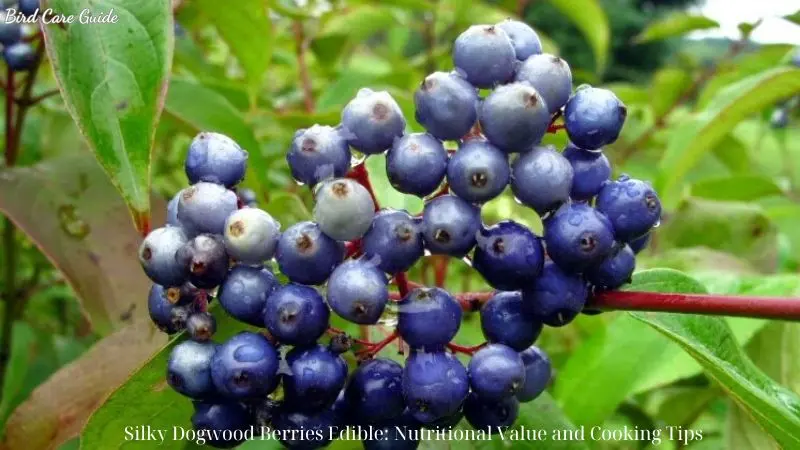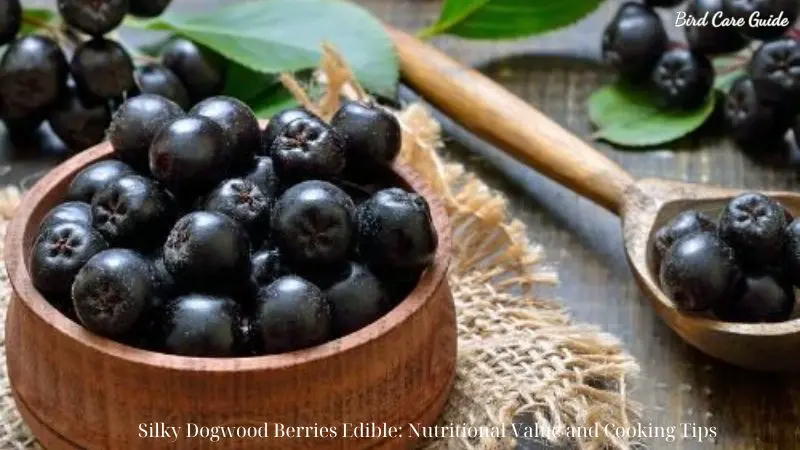Silky dogwood (Cornus amomum), a deciduous shrub native to North America, is well-known for its attractive berries and vibrant foliage. While often celebrated for their aesthetic appeal, the silky dogwood berries edible also hold nutritional value and can be incorporated into various culinary dishes. Let’s “Bird Care Guide” learn about the edible qualities, nutritional benefits, and culinary uses of silky dogwood fruit, providing practical advice for those who want to incorporate silky dogwood fruit into their diet.
Understanding Silky Dogwood
Identification
Silky dogwood is a medium-sized shrub that typically grows between 6 to 10 feet tall. It thrives in wetland areas, along stream banks, and in damp forests. The plant is characterized by:
- Leaves: Opposite, simple leaves that are elliptic to ovate, with smooth edges and prominent veins.
- Flowers: Small, creamy-white flowers that bloom in late spring to early summer, forming in flat-topped clusters.
- Berries: Clusters of blue to bluish-white berries that ripen in late summer to early fall.
Habitat
Silky dogwood is commonly found in the eastern United States and parts of Canada. It prefers moist, well-drained soils and can often be seen growing in riparian zones, floodplains, and wet meadows.
Are Silky Dogwood Berries Edible?

Edibility
The berries of the silky dogwood are indeed edible, though they are not commonly consumed due to their slightly bitter taste. While they are not toxic, their flavor may be an acquired taste for some. The berries can be eaten raw or cooked, and they are often used in jams, jellies, and other preserved forms.
Nutritional Value
Silky dogwood berries are a source of several essential nutrients. While comprehensive nutritional data specific to silky dogwood berries is limited, they are generally known to contain:
Rich in Antioxidants
Silky dogwood berries are packed with antioxidants, which are compounds that help neutralize free radicals in the body. Free radicals can cause oxidative stress, leading to cell damage and various chronic diseases. Consuming antioxidant-rich foods like silky dogwood berries can help reduce the risk of these conditions and promote overall health.
Vitamins and Minerals
While specific nutritional analyses of silky dogwood berries are limited, they are generally known to contain vitamins and minerals common to other berries. These include:
- Vitamin C: Essential for the growth, development, and repair of all body tissues. It’s involved in many body functions, including the formation of collagen, absorption of iron, the immune system, wound healing, and the maintenance of cartilage, bones, and teeth.
- Vitamin K: Important for blood clotting and bone health.
- Fiber: Helps maintain bowel health, lowers cholesterol levels, and helps control blood sugar levels.
Low in Calories
Like most berries, silky dogwood berries are low in calories, making them an excellent addition to a healthy diet. They provide essential nutrients without contributing to excessive caloric intake, making them ideal for those looking to manage their weight.
Harvesting Silky Dogwood Berries
When to Harvest
The best time to harvest silky dogwood berries is in late summer to early fall, when they have fully ripened. The berries will turn a deep blue or bluish-white color when they are ready to be picked.
How to Harvest
- Identification: Ensure that you correctly identify the silky dogwood plant and its berries.
- Collection: Use your hands or a small garden tool to gently remove the berries from the shrub.
- Handling: Handle the berries with care to avoid crushing them.
Preservation
Once harvested, silky dogwood berries can be preserved in several ways:
- Freezing: Spread the berries in a single layer on a baking sheet and freeze them. Once frozen, transfer the berries to a freezer-safe container.
- Drying: Use a dehydrator or an oven set to low heat to dry the berries for long-term storage.
- Canning: Berries can be canned in syrups or used to make jams and jellies.
Incorporating Silky Dogwood Berries into Your Diet
While silky dogwood berries are edible, they are often described as having a mild or slightly bitter taste when eaten raw. However, their flavor can be enhanced and enjoyed in various culinary applications.
1. Jams and Preserves
One of the most popular ways to use silky dogwood berries is to make jams and preserves. The natural pectin in the berries helps the mixture thicken, creating a delicious spread for toast, pastries, or desserts.
Ingredients:
- 4 cups silky dogwood berries
- 2 cups granulated sugar
- 1 tablespoon lemon juice
- 1/2 cup water
Instructions:
- In a large saucepan, combine the berries, sugar, lemon juice, and water.
- Bring the mixture to a boil over medium heat, stirring frequently.
- Reduce the heat and let it simmer for about 20-30 minutes until the berries break down and the mixture thickens.
- Pour the jam into sterilized jars and let it cool before sealing. Store in the refrigerator.
2. Smoothies
Adding silky dogwood berries to smoothies is an excellent way to enjoy their nutritional benefits. They can be blended with other fruits, yogurt, and a liquid of your choice (such as water, milk, or juice) to create a nutritious and refreshing drink.
Ingredients:
- 1 cup silky dogwood berries
- 1 banana
- 1/2 cup Greek yogurt
- 1/2 cup almond milk (or any preferred milk)
- 1 tablespoon honey (optional)
- A handful of spinach (optional)
Instructions:
- Combine all ingredients in a blender.
- Blend until smooth.
- Pour into a glass and enjoy immediately.
3. Salads and Dressings
For a refreshing twist, add silky dogwood berries to salads. Their slight bitterness can contrast nicely with the sweetness of other fruits or the savoriness of greens and nuts. Additionally, you can incorporate the berries into homemade salad dressings.
Ingredients:
- 1/2 cup silky dogwood berries
- 1/4 cup olive oil
- 2 tablespoons balsamic vinegar
- 1 tablespoon honey
- Salt and pepper to taste
Instructions:
- Blend all ingredients in a food processor or blender until smooth.
- Taste and adjust the seasoning as needed.
- Drizzle over salads and enjoy.
4. Teas and Infusions
Silky dogwood berries can also be used to make herbal teas and infusions. Dried berries can be steeped in hot water to create a flavorful and health-boosting beverage.
Ingredients:
- 1/4 cup dried silky dogwood berries
- 2 cups boiling water
- Honey or sweetener to taste (optional)
Instructions:
- Place the dried berries in a teapot or heatproof container.
- Pour the boiling water over the berries.
- Let it steep for 10-15 minutes.
- Strain the tea into cups and sweeten if desired.
Safety Considerations
While silky dogwood berries are edible, it’s important to consume them in moderation, especially if you are new to foraging wild berries. Always ensure that you have correctly identified the plant and that the berries are fully ripe. If you have any concerns or experience any adverse reactions, discontinue use and consult a healthcare professional.
Conclusion
Silky dogwood berries, though not as commonly consumed as other wild berries, offer unique nutritional benefits and culinary possibilities. From jams and smoothies to baked goods and salads, these berries can be incorporated into a variety of dishes to enhance flavor and nutrition. By understanding their nutritional value and experimenting with different cooking methods, you can enjoy the delicious and healthful properties of silky dogwood berries.





